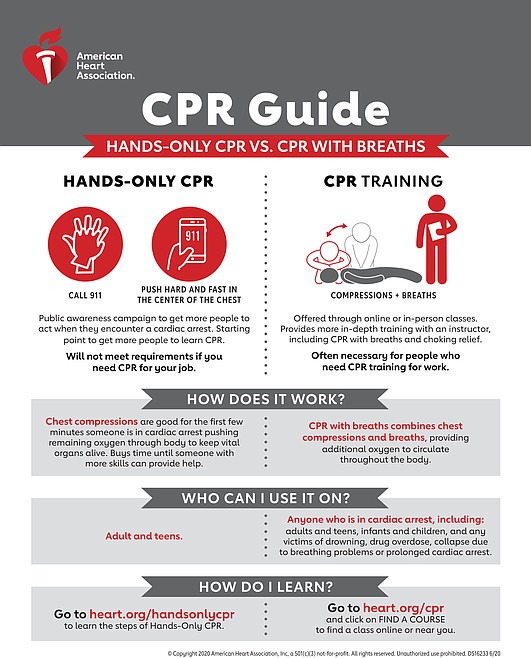Health groups suggest hands-only CPR during pandemic
In the age of COVID-19, CPR remains a vital lifesaving technique when someone experiences cardiac arrest.
Cardiac arrest is an electrical malfunction that causes the heart to stop beating unexpectedly, and a victim will become unresponsive, which is why calling 911 and immediately starting chest compressions is imperative.
Since COVID-19 is believed to spread primarily through respiratory droplets when an infected person coughs, sneezes, or talks, according to Centers for Disease Control and Prevention (CDC) — bystanders may be concerned what the risk is to perform CPR.
“Coronavirus is certainly a virulent pathogen, having said that, initial reports are promising ... . Now, we’re looking at studies looking at actual rates of transmission of coronavirus and infections from CPR being relatively low than originally estimated,” said Dr. Gustavo Flores, a member of the American Heart Association Educational Science and Programs Subcommittee and longtime trainer — but a risk exists.
The risk of getting COVID-19 through CPR may also depend on the prevalence of the virus where a person lives and if the victim is known, or suspected, to have it. As the pandemic evolves, to minimize potential risk of transmission, both the American Heart Association and Red Cross recommend hands-only CPR for adult and teenage cardiac arrest victims. Hands-only CPR means skipping rescue breaths (mouth-to-mouth resuscitation) and giving continuous chest compressions until help arrives. Use an automated external defibrillator (AED) if available. Hands-only CPR has been shown to be as effective as CPR with rescue breaths.
“If anything, we want to make sure people feel empowered to do that and not fear, given the current situation, they will be infected from doing hands-only CPR,” Flores said.
If a mask, or cloth covering, is available, both organizations recommend putting it on the victim to further minimize potential transmission since there is a possibility that compressions may cause respiratory droplets to be expelled. If a victim is suspected to have COVID-19 the Red Cross recommends bystanders performing CPR wear as much protection as possible such as an N-95 mask, eye protection and disposable gloves.
According to the American Heart Association, “In one year alone 475,000 Americans die from a cardiac arrest, CPR when given immediately, can double or triple chances of survival.
Flores said often a cardiac arrest victim will be someone a bystander knows, a friend, family member or neighbor. Nearly 70% of cardiac arrests that occur outside a hospital happen at home. People who live in the same household may be optimal CPR providers since they likely know the risk of transmission, or have both already been exposed to COVID-19.
“That is not going to stop because of coronavirus,” he said about the statistic.
The COVID-19 pandemic didn’t initiate the idea of hands-only CPR, but an interest in getting bystanders to act whether they were trained in CPR or not, or were unwilling to perform mouth-to-mouth resuscitation. In 2008, the American Heart Association released recommendations that stated people could skip rescue breaths.
Although a cardiac arrest victim may gasp or stop breathing, Flores said there is still oxygen in the blood in the minutes after a person collapses.
“The most important step is to make it flow,” Flores said.
Then, if available, a bystander can used an AED, which affects the electrical malfunction.
“Compressions keep the brain alive and the AED fixes the underlying problem,” he said.
Is there a “wrong way” to perform chest compressions that could harm a victim? Flores said it’s a possibility that someone may not generate enough pressure to be effective, but the worst case scenario is doing nothing.
“Let’s put it this way. If somebody is dead, you can’t make it worse. That’s the worst place somebody could be at,” Flores said.
Rescue breaths are still recommended in addition to chest compressions for infants, children, people with severe breathing problems, or incidents of drowning or drug overdoses.
In instances where mouth-to-mouth is necessary, there are one-way face masks available that can be found online at the Red Cross store.
“I keep one in my truck and golf bag,” said Brad Tunnell, Red Cross strategic account executive for Montana, Idaho, Eastern Washington and Alaska. “It’s very lightweight. Fits most children to adults and it’s a one-way barrier that allows you to breathe and nothing really comes back out.”
There are classes available to teach CPR and first aid, which may help a bystander become more confident in his or her abilities.
The American Heart Association and Red Cross offer online courses followed by an in-person skills assessments with a certified trainer. Locally, The Summit in Kalispell currently offers the blended approach of online classes and onsite skills testing at 75 Claremont Street, Suite F. The skills test may be scheduled by calling 751-4100.
Online classes may be easier for people seeking recertification, but new students may want the full classroom experience in person and there are still local options. One local trainer, Roy Testa, owner of Anytime/Anywhere First Aid and CPR, continues to offer onsite classes around the valley. Testa has made changes in following health department and CDC guidelines such as social distancing and small groups. He said each student now practices skills on their own mannequin. Students wear gloves and masks. And, for the time being, Testa teaches rescue breaths by verbally explaining it.
Testa is a proponent of in-person classes because the skills are physical and an instructor is there to correct technique.
“If people are not confident in their skills they’ll hesitate to be a first aid responder,” Testa said. There’s a thing called the five fears of CPR. One is doing something wrong. You’ll have less of a fear if you keep practicing and keep up-to-date on skills.”
Reporter Hilary Matheson may be reached at 758-4431 or hmatheson@dailyinterlake.com.




